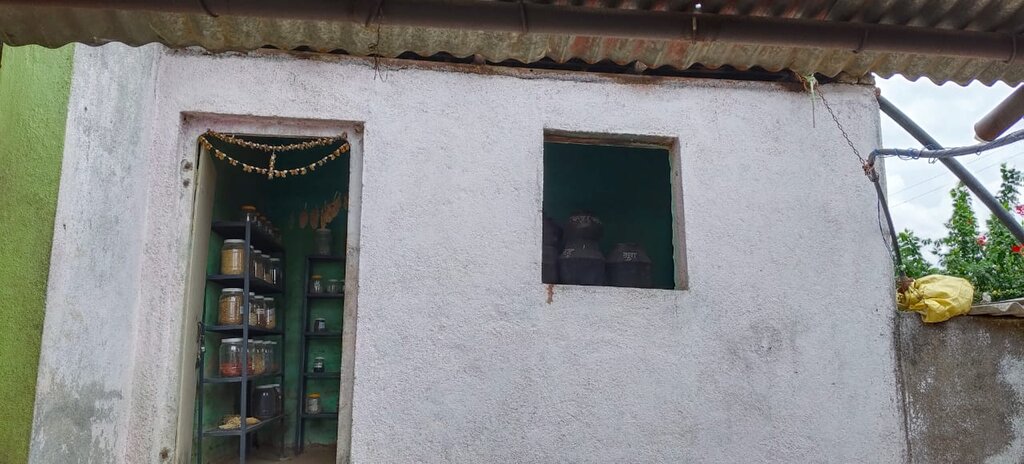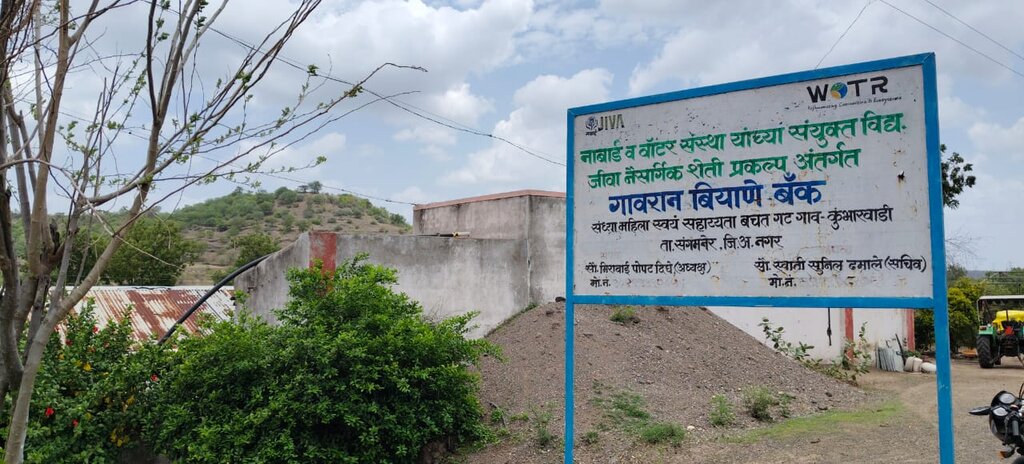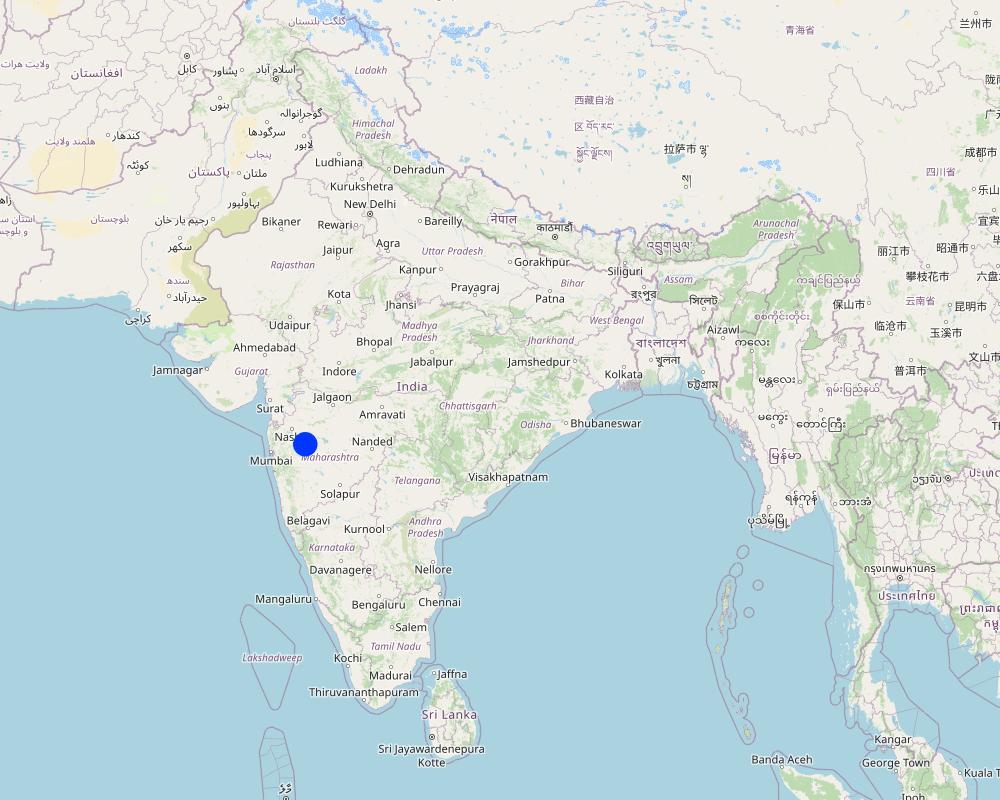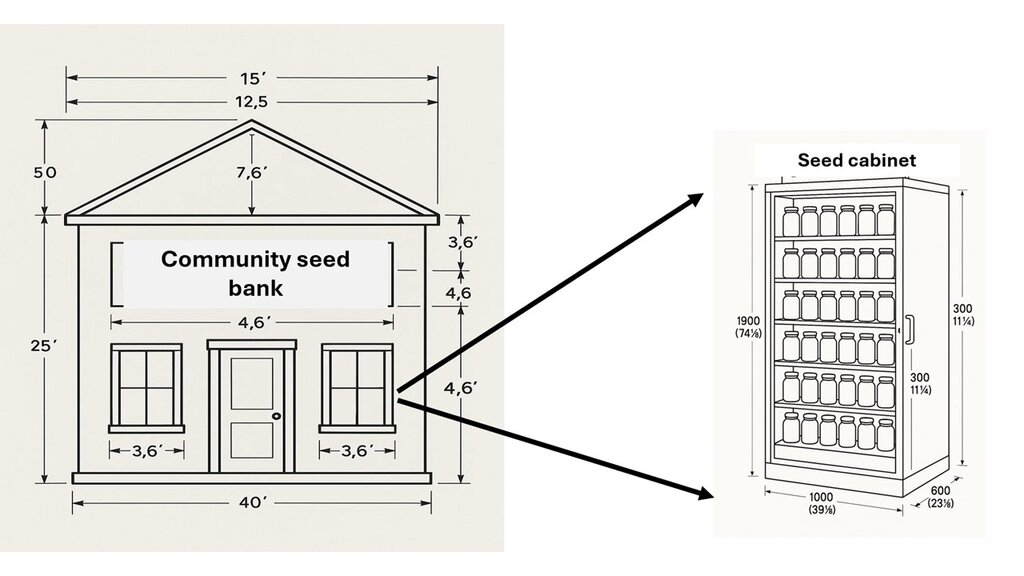Community seed banks [อินเดีย]
- ผู้สร้างสรรค์:
- การอัพเดท:
- ผู้รวบรวม: Pratik Ramteke
- ผู้เรียบเรียง: –
- ผู้ตรวจสอบ: Rima Mekdaschi Studer, William Critchley
Seed banks
technologies_7552 - อินเดีย
ดูส่วนย่อย
ขยายทั้งหมด ย่อทั้งหมด1. ข้อมูลทั่วไป
1.2 รายละเอียดที่ติดต่อได้ของผู้รวบรวมและองค์กรที่เกี่ยวข้องในการประเมินและการจัดเตรียมทำเอกสารของเทคโนโลยี
ชื่อของโครงการซึ่งอำนวยความสะดวกในการทำเอกสารหรือการประเมินเทคโนโลยี (ถ้าเกี่ยวข้อง)
Enabling Agro-ecological Transitions in Rainfed Landscapes (JIVA)1.3 เงื่อนไขการใช้ข้อมูลที่ได้บันทึกผ่านทาง WOCAT
ผู้รวบรวมและวิทยากรหลักยอมรับเงื่อนไขเกี่ยวกับการใช้ข้อมูลที่ถูกบันทึกผ่านทาง WOCAT:
ใช่
1.4 การเปิดเผยเรื่องความยั่งยืนของเทคโนโลยีที่ได้อธิบายไว้
เทคโนโลยีที่ได้อธิบายไว้นี้เป็นปัญหาของความเสื่อมโทรมโทรมของที่ดินหรือไม่ จึงไม่ได้รับการยอมรับว่าเป็นเทคโนโลยีเพื่อการจัดการที่ดินอย่างยั่งยืน:
ไม่ใช่
2. การอธิบายลักษณะของเทคโนโลยี SLM
2.1 การอธิบายแบบสั้น ๆ ของเทคโนโลยี
คำจำกัดความของเทคโนโลยี:
A community-based seed bank system is a locally managed initiative where farmers and community members collect, store, and share seeds to ensure germplasm and food security, preserve crop diversity, and support sustainable agriculture. These banks are governed by community rules.
2.2 การอธิบายแบบละเอียดของเทคโนโลยี
คำอธิบาย:
Community Seed Banks (CSBs) are locally governed systems designed to enhance food and seed security, promote sustainable, climate-resilient farming as well as conserving agrobiodiversity. CSBs bridge traditional agricultural knowledge with evolving best practices, ensuring the continuity of seed diversity adapted to local conditions.
A key function of CSBs is seed preservation and exchange. They provide for the collection of seeds from farmers, prioritizing varieties that have demonstrated superior local adaptation. Seeds are carefully cleaned, dried, and tested for viability before being stored—typically in clay pots in a simple building. The preserved seeds can be used in future planting seasons or distributed during droughts, floods, or pest outbreaks, thereby ensuring timely access to reliable seed material.
A CBS conserves and manages a diverse range of locally important crops including both cereals (sorghum and maize) and legumes (black grams, chickpeas, cowpeas, green grams, green peas, groundnuts, horse grams, red grams, and soybeans). Several traditional and improved cultivars of each crop are stored, selected on their performance under local conditions, including drought tolerance, pest and disease resistance, yield stability, and cultural preference. The quantity of seeds stored per cultivar ranges from 500 grams to 100 kilograms, depending on availability and community demand. For seed protection, both indigenous practices and materials such as wood ash, neem leaves (Azadirachta indica), and chili extract (Capsicum frutescens) are used to prevent pest infestation during storage, minimizing reliance on commercial pesticides.
Management of CSBs is local and participatory. They are generally governed by elected community committees that set the rules for deposit, withdrawal and replenishment. This governance structure ensures that the seed bank reflects the specific needs and knowledge systems of the community. Community engagement is not only vital for operational success but also fosters a sense of ownership and collective responsibility.
CSBs play a multifaceted role. They contribute to agrobiodiversity conservation by safeguarding traditional and wild crop varieties, which are invaluable for future breeding programs. Furthermore, they ensure that farmers can access seeds during critical periods. Additionally, CSBs promote sustainable agricultural practices by reducing reliance on commercial seed systems. They also help to document and share traditional farming knowledge.
The operational structure of a CSB begins with community mobilization and capacity-building focused on seed selection, handling, and storage. Infrastructure requirements are modest. Maintenance involves tasks such as viability testing to ensure the germination potential of stored seeds.
CSBs enhance the resilience of agricultural systems by enabling communities to recover swiftly from crop failures: they also reduce input costs. Furthermore, CSBs empower communities—particularly smallholder farmers and women. Moreover, these banks store vital genetic material for future research.
From a community perspective, the benefits are substantial. However, challenges remain. High initial investments in infrastructure and training are required, and ongoing success depends on strong community engagement and diligent record-keeping. Nevertheless, by preserving the genetic heritage of crops and empowering local communities, CSBs reduce contribute to food sovereignty
2.3 รูปภาพของเทคโนโลยี
2.5 ประเทศภูมิภาค หรือสถานที่ตั้งที่เทคโนโลยีได้นำไปใช้และได้รับการครอบคลุมโดยการประเมินนี้
ประเทศ:
อินเดีย
ภูมิภาค/รัฐ/จังหวัด:
Maharashtra
ข้อมูลจำเพาะเพิ่มเติมของสถานที่ตั้ง :
Kumbharwadi village, Tal. Sangamner, Dist: Ahilyanagar
ระบุการกระจายตัวของเทคโนโลยี:
- ใช้ ณ จุดที่เฉพาะเจาะจงหรือเน้นไปยังบริเวณพื้นที่ขนาดเล็ก
Is/are the technology site(s) located in a permanently protected area?
ไม่ใช่
แสดงความคิดเห็น:
This documentation covers a single CSB located at Kumbharwadi village.
Map
×2.6 วันที่การดำเนินการ
ระบุปีที่ใช้:
2024
2.7 คำแนะนำของเทคโนโลยี
ให้ระบุว่าเทคโนโลยีถูกแนะนำเข้ามาอย่างไร:
- ทางโครงการหรือจากภายนอก
ความคิดเห็น (ประเภทของโครงการ เป็นต้น) :
JIVA – An Agroecology-Based Programme, Implementing Agency: National Bank for Agriculture and Rural Development (NABARD)
3. การจัดประเภทของเทคโนโลยี SLM
3.1 วัตถุประสงค์หลักของเทคโนโลยี
- ปรับปรุงการผลิตให้ดีขึ้น
- รักษาสภาพหรือปรับปรุงความหลากหลายทางชีวภาพ
- ปรับตัวเข้ากับการเปลี่ยนแปลงภูมิอากาศของโลก สภาพภูมิอากาศที่รุนแรงและผลกระทบ
- สร้างผลกระทบทางด้านเศรษฐกิจที่เป็นประโยชน์
- สร้างผลกระทบทางด้านสังคมที่เป็นประโยชน์
3.2 ประเภทของการใช้ที่ดินในปัจจุบันที่ได้นำเทคโนโลยีไปใช้
Land use mixed within the same land unit:
ใช่
Specify mixed land use (crops/ grazing/ trees):
- วนเกษตร (Agroforestry)

พื้นที่ปลูกพืช
- การปลูกพืชล้มลุกอายุปีเดียว
- การปลูกไม้ยืนต้น ไม้พุ่ม
Annual cropping - Specify crops:
- cereals - maize
- cereals - millet
- fodder crops - alfalfa
- legumes and pulses - soya
- vegetables - root vegetables (carrots, onions, beet, other)
Tree and shrub cropping - Specify crops:
- mango, mangosteen, guava
- Custard Apple
จำนวนของฤดูเพาะปลูกต่อปี:
- 2
Is intercropping practiced?
ใช่
If yes, specify which crops are intercropped:
Red gram, black gram and green gram intercropped with pearl millet or soybean;
cowpea, horse gram intercropped with groundnuts
Is crop rotation practiced?
ใช่
ถ้าใช่ ระบุ:
Cereals-pulses

ป่า/พื้นที่ทำไม้
- ป่า/พื้นที่ทำไม้

ทางน้ำ แหล่งน้ำ พื้นที่ชุ่มน้ำ
- บ่อน้ำ เขื่อน
ผลิตภัณฑ์หลักหรือบริการ:
Irrigation and domestic use
3.3 Has land use changed due to the implementation of the Technology?
Has land use changed due to the implementation of the Technology?
- No (Continue with question 3.4)
3.4 การใช้น้ำ
การใช้น้ำของที่ดินที่มีการใช้เทคโนโลยีอยู่:
- น้ำฝนร่วมกับการชลประทาน
แสดงความคิดเห็น:
Irrigation source: well, farm pond
3.5 กลุ่ม SLM ที่ตรงกับเทคโนโลยีนี้
- การจัดการศัตรูพืชและโรคพืชแบบผสมผสาน (รวมถึงเกษตรอินทรีย์ด้วย)
- การปรับปรุงพันธุ์พืชหรือพันธุ์สัตว์ต่าง ๆ
- การลดความเสี่ยงจากภัยพิบัติบนพื้นฐานของระบบนิเวศ
3.6 มาตรการ SLM ที่ประกอบกันเป็นเทคโนโลยี

มาตรการอนุรักษ์ด้วยโครงสร้าง
- S9: ที่พักพิงสำหรับพืชและสัตว์
- S11: อื่น ๆ
แสดงความคิดเห็น:
The CSB includes permanent infrastructure (e.g., a small house or storage facility built with community effort) for the secure preservation and storage of seeds.
3.7 รูปแบบหลักของการเสื่อมโทรมของที่ดินที่ได้รับการแก้ไขโดยเทคโนโลยี

การเสื่อมโทรมของดินทางด้านเคมี
- Cn (Fertility decline): ความอุดมสมบูรณ์และปริมาณอินทรียวัตถุในดินถูกทำให้ลดลงไป (ไม่ได้เกิดจากสาเหตุการกัดกร่อน)

การเสื่อมโทรมของดินทางด้านชีวภาพ
- Bh (Loss of habitat): การสูญเสียแหล่งที่อยู่
- Bs (Quality and species composition): องค์ประกอบหรือความหลากหลายทางคุณภาพและชนิดพันธุ์ลดลง
- Bp (Increase of pests/diseases): การเพิ่มขึ้นของศัตรูพืชและโรคพืช

การเสื่อมโทรมของน้ำ
- Hg (Change in groundwater): การเปลี่ยนแปลงของน้ำบาดาลหรือระดับน้ำในแอ่งน้ำบาดาล

อื่น ๆ
ระบุ:
Agrobiodiversity loss and climate-related seed insecurity
→ The CSB addresses the degradation of crop genetic resources, which is a foundational pillar of sustainable land management.
3.8 การป้องกัน การลดลง หรือการฟื้นฟูความเสื่อมโทรมของที่ดิน
ระบุเป้าหมายของเทคโนโลยีกับความเสื่อมโทรมของที่ดิน:
- ป้องกันความเสื่อมโทรมของที่ดิน
- ลดความเสื่อมโทรมของดิน
แสดงความคิดเห็น:
→ By conserving traditional seed varieties that require fewer external inputs, the CSB helps prevent soil and biodiversity degradation.
→ Promoting resilient, diverse, and low-input seed systems contributes to reducing ongoing degradation (e.g., fertility decline, loss of biodiversity).
4. ข้อมูลจำเพาะด้านเทคนิค กิจกรรมการนำไปปฏิบัติใช้ ปัจจัยนำเข้า และค่าใช้จ่าย
4.1 แบบแปลนทางเทคนิคของเทคโนโลยี
ข้อมูลจำเพาะด้านเทคนิค (แบบแปลนทางเทคนิคของเทคโนโลยี):
The structure shown is for reference. Any enclosed room with suitable ventilation and storage conditions can serve as a seed bank.
More detail of storage pots and a brief description:
The seed bank utilizes traditional earthen pots (locally known as matka or bharani) and airtight glass/plastic jars as primary storage containers. The large clay pots are arranged on raised platforms and shelves to avoid moisture contact from the floor. These pots are labelled in local script (Marathi), clearly indicating the crop name (e.g., sorghum, cowpea, maize, etc.) and variety stored. Each pot is covered with cloth and tied securely, ensuring ventilation while preventing pest entry.
These earthen pots are ideal for seed storage in rural, low-cost setups as they:
•Maintain cool internal temperatures, reducing seed deterioration.
•Are naturally aerated, preventing moisture buildup.
•Can be easily sealed using cloth or organic sealants like cow dung or ash to control pests.
The glass and plastic jars used on metal racks are suited for small seed quantities, mainly for short-term storage or display during training sessions and exchanges. Each jar is labelled with variety and harvest details, supporting proper documentation and traceability.
ผู้เขียน:
Pratik Ramteke
วันที่:
12/05/2025
4.2 ข้อมูลทั่วไปเกี่ยวกับการคำนวณปัจจัยนำเข้าและค่าใช้จ่าย
ให้ระบุว่าค่าใช้จ่ายและปัจจัยนำเข้าได้รับการคำนวณอย่างไร:
- ต่อหน่วยเทคโนโลยี
โปรดระบุหน่วย:
1
Specify dimensions of unit (if relevant):
A typical unit consists of a single room structure (approx. 10 x 10 feet) equipped with traditional clay pots (15–25 units) and glass or plastic jars (20–50 units) used for storing seeds. The average storage capacity of one unit is approximately 200–500 kg, depending on the number of crop varieties and seasonal seed availability.
อื่นๆ หรือสกุลเงินประจำชาติ (ระบุ):
Indian Rupees
If relevant, indicate exchange rate from USD to local currency (e.g. 1 USD = 79.9 Brazilian Real): 1 USD =:
84.0
ระบุค่าเฉลี่ยของค่าจ้างในการจ้างแรงงานต่อวัน:
500
4.3 กิจกรรมเพื่อการจัดตั้ง
| กิจกรรม | Timing (season) | |
|---|---|---|
| 1. | Site selection for seed bank structure (within SHG household/community building) | February–March (before Rabi harvest) |
| 2. | Construction/preparation of storage structure (room cleaning, plastering, shelf fixing) | March–April |
| 3. | Procurement of local seed varieties | April–May (before monsoon/ Kharif sowing) |
| 4. | Procurement and setup of seed storage containers (clay pots, glass jars, bags) | April–May (before onset of rain) |
| 5. | Installation of racks, shelves, moisture absorbers | May |
| 6. | Labelling of containers and organization of storage system | May–June |
| 7. | Setup of documentation tools (register books, seed stock cards) | June (onset of monsoon) |
4.4 ค่าใช้จ่ายของปัจจัยนำเข้าที่จำเป็นสำหรับการจัดตั้ง
| ปัจจัยนำเข้า | หน่วย | ปริมาณ | ค่าใช้จ่ายต่อหน่วย | ค่าใช้จ่ายทั้งหมดต่อปัจจัยนำเข้า | %ของค่าใช้จ่ายที่ก่อให้เกิดขึ้นโดยผู้ใช้ที่ดิน | |
|---|---|---|---|---|---|---|
| แรงงาน | Trainer Fees | person days | 1.0 | 2500.0 | 2500.0 | |
| อุปกรณ์ | Furniture / Rack | pieces | 10.0 | 800.0 | 8000.0 | |
| อุปกรณ์ | Seed Store Jar and Bag | pieces | 200.0 | 20.0 | 4000.0 | |
| วัสดุด้านพืช | Purchase of seed | kg | 50.0 | 450.0 | 22500.0 | |
| อื่น ๆ | Training food charges, materials, boards, exposure visit charges, register book, charts, etc. | 1.0 | 8100.0 | 8100.0 | ||
| ค่าใช้จ่ายทั้งหมดของการจัดตั้งเทคโนโลยี | 45100.0 | |||||
| Total costs for establishment of the Technology in USD | 536.9 | |||||
ถ้าผู้ใช้ที่ดินรับภาระน้อยกว่า 100% ของค่าใช้จ่าย ให้ระบุว่าใครเป็นผู้รับผิดชอบส่วนที่เหลือ:
Project
แสดงความคิดเห็น:
Around 90-95% of costs were supported by the implementing project JIVA (NABARD), while the remaining was contributed by the community through local materials and voluntary labour
4.5 การบำรุงรักษาสภาพหรือกิจกรรมที่เกิดขึ้นเป็นประจำ
| กิจกรรม | ช่วงระยะเวลา/ความถี่ | |
|---|---|---|
| 1. | Labour (e.g., supervision, helpers) | each cropping season |
| 2. | Replacement of broken jars | as per need |
| 3. | Labelling changes (charts, tags) | annually |
| 4. | Equipment maintenance and repair | as per need |
4.6 ค่าใช้จ่ายของปัจจัยนำเข้าและกิจกรรมที่เกิดขึ้นเป็นประจำที่ต้องการการบำรุงรักษา (ต่อปี)
| ปัจจัยนำเข้า | หน่วย | ปริมาณ | ค่าใช้จ่ายต่อหน่วย | ค่าใช้จ่ายทั้งหมดต่อปัจจัยนำเข้า | %ของค่าใช้จ่ายที่ก่อให้เกิดขึ้นโดยผู้ใช้ที่ดิน | |
|---|---|---|---|---|---|---|
| แรงงาน | Labour (e.g., supervision, helpers) | man-days | 10.0 | 300.0 | 3000.0 | |
| อุปกรณ์ | Replacement of broken jars | pieces | 10.0 | 20.0 | 200.0 | |
| อุปกรณ์ | Labelling changes (charts, tags) | 5.0 | 300.0 | 1500.0 | ||
| อุปกรณ์ | Equipment maintenance and repair | 1.0 | 2000.0 | 2000.0 | ||
| วัสดุด้านพืช | 1.0 | |||||
| ค่าใช้จ่ายทั้งหมดของการบำรุงรักษาสภาพเทคโนโลยี | 6700.0 | |||||
| Total costs for maintenance of the Technology in USD | 79.76 | |||||
ถ้าผู้ใช้ที่ดินรับภาระน้อยกว่า 100% ของค่าใช้จ่าย ให้ระบุว่าใครเป็นผู้รับผิดชอบส่วนที่เหลือ:
Project (see above under Establishment)
4.7 ปัจจัยสำคัญที่สุดที่มีผลกระทบต่อค่าใช้จ่าย
ปัจจัยสำคัญที่สุดที่มีผลกระทบต่อค่าใช้จ่ายต่างๆ:
1. Seed procurement and quality maintenance
2. Storage infrastructure (jars, bags, racks)
3. Training and capacity building for SHGs
4. Labelling and documentation materials
5. Community engagement and operational labour
6. Monitoring and evaluation activities
7. Exposure visits and knowledge sharing
8. Replacement and maintenance of storage materials
5. สิ่งแวดล้อมทางธรรมชาติและของมนุษย์
5.1 ภูมิอากาศ
ฝนประจำปี
- < 250 ม.ม.
- 251-500 ม.ม.
- 501-750 ม.ม.
- 751-1,000 ม.ม.
- 1,001-1,500 ม.ม.
- 1,501-2,000 ม.ม.
- 2,001-3,000 ม.ม.
- 3,001-4,000 ม.ม.
- > 4,000 ม.ม.
ระบุปริมาณน้ำฝนเฉลี่ยรายปี (ถ้ารู้) :หน่วย ม.ม.
450.00
เขตภูมิอากาศเกษตร
- กึ่งแห้งแล้ง
5.2 สภาพภูมิประเทศ
ค่าเฉลี่ยความลาดชัน:
- ราบเรียบ (0-2%)
- ลาดที่ไม่ชัน (3-5%)
- ปานกลาง (6-10%)
- เป็นลูกคลื่น (11-15%)
- เป็นเนิน (16-30%)
- ชัน (31-60%)
- ชันมาก (>60%)
ธรณีสัณฐาน:
- ที่ราบสูง/ที่ราบ
- สันเขา
- ไหล่เขา
- ไหล่เนินเขา
- ตีนเนิน
- หุบเขา
ระดับความสูง:
- 0-100 เมตร
- 101-500 เมตร
- 501-1,000 เมตร
- 1,001-1,500 เมตร
- 1,501-2,000 เมตร
- 2,001-2,500 เมตร
- 2,501-3,000 เมตร
- 3,001-4,000 เมตร
- > 4,000 เมตร
ให้ระบุถ้าเทคโนโลยีได้ถูกนำไปใช้:
- ไม่เกี่ยวข้อง
5.3 ดิน
ค่าเฉลี่ยความลึกของดิน:
- ตื้นมาก (0-20 ซ.ม.)
- ตื้น (21-50 ซ.ม.)
- ลึกปานกลาง (51-80 ซ.ม.)
- ลึก (81-120 ซ.ม.)
- ลึกมาก (>120 ซ.ม.)
เนื้อดิน (ดินชั้นบน):
- หยาบ/เบา (ดินทราย)
เนื้อดินล่าง (> 20 ซ.ม.ต่ำจากผิวดิน):
- หยาบ/เบา (ดินทราย)
อินทรียวัตถุในดิน:
- ต่ำ (<1%)
(ถ้ามี) ให้แนบคำอธิบายเรื่องดินแบบเต็มหรือระบุข้อมูลที่มีอยู่ เช่น ชนิดของดิน ค่า pH ของดินหรือความเป็นกรดของดิน ความสามารถในการแลกเปลี่ยนประจุบวก ไนโตรเจน ความเค็ม เป็นต้น:
calcareous
5.4 ความเป็นประโยชน์และคุณภาพของน้ำ
ระดับน้ำใต้ดิน:
5-50 เมตร
น้ำไหลบ่าที่ผิวดิน:
ไม่ดีหรือไม่มีเลย
คุณภาพน้ำ (ที่ยังไม่ได้บำบัด):
เป็นน้ำเพื่อการดื่มที่ไม่ดี (จำเป็นต้องได้รับการบำบัด)
Water quality refers to:
ground water
ความเค็มของน้ำเป็นปัญหาหรือไม่:
ใช่
กำลังเกิดน้ำท่วมในพื้นที่หรือไม่:
ไม่ใช่
5.5 ความหลากหลายทางชีวภาพ
ความหลากหลายทางชนิดพันธุ์:
- สูง
ความหลากหลายของแหล่งที่อยู่:
- ปานกลาง
ความคิดเห็นและข้อมูลจำเพาะเพิ่มเติมของความหลากหลายทางชีวภาพ:
The Community Seed Bank maintains and promotes high agrobiodiversity in the surrounding farming areas by preserving a wide range of traditional and locally adapted crop varieties. In total, over 30+ landraces/varieties across 2 cereals and 9 legumes/ pulses (sorghum, maize; green grams, chick peas, horse grams, cowpeas, red grams, green peas, black grams, soybeans and groundnuts) are being actively conserved and circulated in the local community. This contributes significantly to on-farm agrobiodiversity, improves ecosystem resilience, and reduces dependence on uniform commercial seed systems. The continued use and exchange of these seeds by farmers helps sustain crop diversity in the region.
5.6 ลักษณะของผู้ใช้ที่ดินที่นำเทคโนโลยีไปปฏิบัติใช้
อยู่กับที่หรือเร่ร่อน:
- อยู่กับที่
แนวทางการตลาดของระบบการผลิต:
- mixed (subsistence/ commercial)
- ทำการค้า/การตลาด
รายได้ที่มาจากนอกฟาร์ม:
- 10-50% ของรายได้ทั้งหมด
ระดับของความมั่งคั่งโดยเปรียบเทียบ:
- พอมีพอกิน
เป็นรายบุคคล/ครัวเรือน:
- เป็นรายบุคคล/ครัวเรือน
ระดับของการใช้เครื่องจักรกล:
- งานที่ใช้แรงกาย
- การใช้เครื่องจักรหรือเครื่องยนต์
เพศ:
- หญิง
- ชาย
อายุของผู้ใช้ที่ดิน:
- ผู้เยาว์
- วัยกลางคน
- ผู้สูงอายุ
5.7 Average area of land used by land users applying the Technology
- < 0.5 เฮกตาร์
- 0.5-1 เฮกตาร์
- 1-2 เฮกตาร์
- 2-5 เฮกตาร์
- 5-15 เฮกตาร์
- 15-50 เฮกตาร์
- 50-100 เฮกตาร์
- 100-500 เฮกตาร์
- 500-1,000 เฮกตาร์
- 1,000-10,000 เฮกตาร์
- >10,000 เฮกตาร์
พิจารณาว่าเป็นขนาดเล็ก กลาง หรือขนาดใหญ่ (ซึ่งอ้างอิงถึงบริบทระดับท้องถิ่น):
- ขนาดกลาง
5.8 กรรมสิทธิ์ในที่ดิน สิทธิในการใช้ที่ดินและสิทธิในการใช้น้ำ
กรรมสิทธิ์ในที่ดิน:
- เป็นแบบชุมชนหรือหมู่บ้าน
- รายบุคคล ได้รับสิทธิครอบครอง
สิทธิในการใช้ที่ดิน:
- เกี่ยวกับชุมชน (ถูกจัดระเบียบ)
- รายบุคคล
สิทธิในการใช้น้ำ:
- เกี่ยวกับชุมชน (ถูกจัดระเบียบ)
- รายบุคคล
Are land use rights based on a traditional legal system?
ใช่
ระบุ:
Land is traditionally managed by village communities or panchayats, with individual families allocated specific plots for cultivation, based on customary rights and community norms.
แสดงความคิดเห็น:
Both formal titles and long-standing traditional practices often govern land and water use. Community seed bank activities are usually hosted on land provided by local institutions or SHGs with shared usage rights.
5.9 การเข้าถึงบริการและโครงสร้างพื้นฐาน
สุขภาพ:
- จน
- ปานกลาง
- ดี
การศึกษา:
- จน
- ปานกลาง
- ดี
ความช่วยเหลือทางด้านเทคนิค:
- จน
- ปานกลาง
- ดี
การจ้างงาน (เช่น ภายนอกฟาร์ม):
- จน
- ปานกลาง
- ดี
ตลาด:
- จน
- ปานกลาง
- ดี
พลังงาน:
- จน
- ปานกลาง
- ดี
ถนนและการขนส่ง:
- จน
- ปานกลาง
- ดี
น้ำดื่มและการสุขาภิบาล:
- จน
- ปานกลาง
- ดี
บริการด้านการเงิน:
- จน
- ปานกลาง
- ดี
6. ผลกระทบและสรุปคำบอกกล่าว
6.1 ผลกระทบในพื้นที่ดำเนินการ (On-site) จากการใช้เทคโนโลยี
ผลกระทบทางด้านเศรษฐกิจและสังคม
การผลิต
การผลิตพืชผล
แสดงความคิดเห็น/ระบุ:
The Community Seed Bank has contributed to stabilizing crop production rather than significantly increasing it. By providing access to diverse, locally adapted, and resilient seed varieties, the seed bank has helped reduce yield losses during droughts, erratic rainfall, and pest outbreaks, which are common in the region. Farmers report more consistent harvests across seasons, especially in rainfed areas where climate variability poses a major risk.
การผลิตพืชที่ใช้เลี้ยงปศุสัตว์
แสดงความคิดเห็น/ระบุ:
Community seed banks play a crucial role in enhancing fodder production, particularly in smallholder and mixed farming systems. By conserving and providing access to diverse and locally adapted fodder crop varieties, these seed banks help improve the availability and quality of fodder throughout the year. This supports livestock health and productivity, especially during dry seasons or climate-induced fodder shortages. Moreover, farmers can select fodder species that are well-suited to local conditions, which enhances biomass yield and nutritional content. As a result, community seed banks contribute to better livestock management, reduced feed costs, and improved farm income and resilience.
A few traditional fodder crops are also conserved through the seed bank, including:
•Sorghum (dual-purpose varieties used for both grain and fodder)
•Horse gram (used as green fodder in early stages)
•Cowpea and black gram (both provide leafy biomass for fodder)
Propagation method:
These species are primarily stored and distributed as seeds through the seed bank. However, in some cases, vegetative splits of perennial fodder grasses (like Napier or Guinea grass) are maintained in adjacent farmer-managed plots, though this is outside the core seed bank structure and is coordinated informally by SHG members.
คุณภาพพืชที่ใช้เลี้ยงปศุสัตว์
แสดงความคิดเห็น/ระบุ:
Community seed banks enhance fodder quality by providing access to diverse, locally adapted fodder varieties with better nutritional content. This supports healthier livestock and improves milk and meat productivity.
การผลิตสัตว์
แสดงความคิดเห็น/ระบุ:
Community seed banks support animal production by ensuring a steady supply of high-quality fodder, which improves livestock nutrition and health. This leads to increased milk yield, better weight gain, and overall improved animal productivity.
การเสี่ยงต่อความล้มเหลวในการผลิต
แสดงความคิดเห็น/ระบุ:
Community seed banks reduce the risk of production failure by offering diverse, locally adapted seed varieties that are more resilient to pests, diseases, and climate stress. This genetic diversity helps stabilize yields and ensures better crop survival under adverse conditions.
การจัดการที่ดิน
แสดงความคิดเห็น/ระบุ:
Community seed banks promote better land management by encouraging the use of traditional and climate-resilient crop varieties that are well-suited to local soils and conditions. This supports sustainable farming practices, reduces the need for chemical inputs, and helps maintain soil health and fertility.
ความเป็นประโยชน์และคุณภาพของน้ำ
การมีน้ำไว้ให้สำหรับการชลประทาน
แสดงความคิดเห็น/ระบุ:
Community seed banks contribute to improved irrigation water availability by promoting drought-tolerant and water-efficient crop varieties. These varieties require less water, helping farmers conserve irrigation resources and maintain productivity during water-scarce periods.
รายได้และค่าใช้จ่าย
ค่าใช่จ่ายของปัจจัยการผลิตทางการเกษตร
แสดงความคิดเห็น/ระบุ:
Community seed banks help reduce expenses on agricultural inputs by providing farmers with free or low-cost seeds, minimizing the need to purchase commercial seeds. They also promote the use of traditional, low-input crop varieties, which often require fewer fertilizers and pesticides.
ผลกระทบด้านนิเวศวิทยา
วัฐจักรน้ำหรือน้ำบ่า
คุณภาพน้ำ
แสดงความคิดเห็น/ระบุ:
Reduced agrochemical use linked with traditional varieties.
การเก็บเกี่ยวหรือการกักเก็บน้ำ
แสดงความคิดเห็น/ระบุ:
Seed bank farmers often adopt moisture conservation practices.
น้ำไหลบ่าที่ผิวดิน
แสดงความคิดเห็น/ระบุ:
Improved ground cover from diversified cropping.
การระบายน้ำส่วนเกิน
น้ำบาดาลหรือระดับน้ำในแอ่งน้ำบาดาล
แสดงความคิดเห็น/ระบุ:
Due to adoption of traditional drought-tolerant and short-duration crops.
การระเหย
แสดงความคิดเห็น/ระบุ:
Better mulching and cover practices.
ดิน
ความชื้นในดิน
แสดงความคิดเห็น/ระบุ:
Traditional crops conserve more soil moisture.
สิ่งปกคลุมดิน
แสดงความคิดเห็น/ระบุ:
Due to mixed/intercropping encouraged with native seeds.
การสูญเสียดิน
แสดงความคิดเห็น/ระบุ:
Improved ground cover
การหมุนเวียนและการเติมของธาตุอาหาร
ความหลากหลายทางชีวภาพของพืชและสัตว์
การปกคลุมด้วยพืช
แสดงความคิดเห็น/ระบุ:
More resilient and diverse crop cover.
มวลชีวภาพ/เหนือดินชั้น C
แสดงความคิดเห็น/ระบุ:
Enhanced crop residues and fodder availability
ความหลากหลายทางชีวภาพของพืช
แสดงความคิดเห็น/ระบุ:
Local seeds increase genetic diversity.
พืชพันธุ์ต่างถิ่นที่รุกล้ำเข้ามา
แสดงความคิดเห็น/ระบุ:
Minimal effect; some replacement of hybrids.
ความหลากหลายทางชีวภาพของสัตว์
แสดงความคิดเห็น/ระบุ:
Indigenous cropping supports native fauna.
ชนิดพันธุ์ที่ให้ประโยชน์
แสดงความคิดเห็น/ระบุ:
Pollinators and natural predators increased.
ความหลากหลายของสัตว์
แสดงความคิดเห็น/ระบุ:
Seed banks revive landrace-driven agro-ecosystems.
การจัดการศัตรูพืชและโรคพืช
แสดงความคิดเห็น/ระบุ:
Traditional varieties are often resistant.
ลดความเสี่ยงของภัยพิบัติ
ผลกระทบจากน้ำท่วม
แสดงความคิดเห็น/ระบุ:
More stable cropping systems.
ผลกระทบจากภัยแล้ง
แสดงความคิดเห็น/ระบุ:
Drought-tolerant crops used.
การปล่อยคาร์บอนและก๊าซเรือนกระจก
แสดงความคิดเห็น/ระบุ:
Reduced fertilizer use.
ความเร็วของลม
แสดงความคิดเห็น/ระบุ:
Increased cover reduces erosion
ภูมิอากาศจุลภาค
แสดงความคิดเห็น/ระบุ:
More vegetative cover and soil moisture.
Specify assessment of on-site impacts (measurements):
Estimates based on a mixture of science-based observations and expectations, and community-based local knowledge
6.2 ผลกระทบนอกพื้นที่ดำเนินการ (Off-site) จากการใช้เทคโนโลยี
น้ำที่ใช้ประโยชน์ได้
แสดงความคิดเห็น/ระบุ:
Due to improved recharge and less runoff.
น้ำท่วมพื้นที่ท้ายน้ำ
แสดงความคิดเห็น/ระบุ:
Less runoff due to cover.
การทับถมของดินตะกอนพื้นที่ท้ายน้ำ
แสดงความคิดเห็น/ระบุ:
Soil conservation from better cover.
การเกิดมลพิษในน้ำบาดาลหรือแม่น้ำ
แสดงความคิดเห็น/ระบุ:
Reduced chemical input.
ความเสียหายต่อพื้นที่เพาะปลูกของเพื่อนบ้าน
แสดงความคิดเห็น/ระบุ:
Less runoff.
ผลกระทบของก๊าซเรือนกระจก
แสดงความคิดเห็น/ระบุ:
Reduced fertilizer usage and better biomass.
Specify assessment of off-site impacts (measurements):
Based on field observations, local knowledge, and documentation by SHG members.
Proxy indicators: changes in vegetation cover, crop diversity, seasonal water availability, soil health traits.
6.3 การเผชิญและความตอบสนองของเทคโนโลยีต่อการเปลี่ยนแปลงสภาพภูมิอากาศที่ค่อยเป็นค่อยไป และสภาพรุนแรงของภูมิอากาศ / ภัยพิบัติ (ที่รับรู้ได้โดยผู้ใช้ที่ดิน)
การเปลี่ยนแปลงสภาพภูมิอากาศที่ค่อยเป็นค่อยไป
การเปลี่ยนแปลงสภาพภูมิอากาศที่ค่อยเป็นค่อยไป
| ฤดู | increase or decrease | เทคโนโลยีมีวิธีการรับมืออย่างไร | |
|---|---|---|---|
| อุณหภูมิประจำปี | เพิ่มขึ้น | ดีมาก | |
| ฝนประจำปี | ลดลง | ดีมาก | |
| ฝนตามฤดู | ฤดูฝน | ลดลง | ดีมาก |
สภาพรุนแรงของภูมิอากาศ (ภัยพิบัติ)
ภัยพิบัติทางอุตุนิยมวิทยา
| เทคโนโลยีมีวิธีการรับมืออย่างไร | |
|---|---|
| พายุลูกเห็บประจำท้องถิ่น | ดี |
| พายุลมประจำท้องถิ่น | ดี |
ภัยพิบัติจากน้ำ
| เทคโนโลยีมีวิธีการรับมืออย่างไร | |
|---|---|
| น้ำท่วมฉับพลัน | ปานกลาง |
| ดินถล่ม | ปานกลาง |
แสดงความคิดเห็น:
Community Seed Banks act as a resilient strategy by:
Ensuring timely seed availability during disasters.
Preserving genetic diversity to cope with stress.
Enhancing local adaptive capacity.
6.4 การวิเคราะห์ค่าใช้จ่ายและผลประโยชน์ที่ได้รับ
ผลประโยชน์ที่ได้รับเปรียบเทียบกับค่าใช้จ่ายในการจัดตั้งเป็นอย่างไร (จากมุมมองของผู้ใช้ที่ดิน)
ผลตอบแทนระยะสั้น:
ด้านลบเล็กน้อย
ผลตอบแทนระยะยาว:
ด้านบวก
ผลประโยชน์ที่ได้รับเปรียบเทียบกับค่าใช้จ่ายในการบำรุงรักษาหรือต้นทุนที่เกิดขึ้นซ้ำอีก เป็นอย่างไร (จากมุมมองของผู้ใช้ที่ดิน)
ผลตอบแทนระยะสั้น:
เป็นกลางหรือสมดุล
ผลตอบแทนระยะยาว:
ด้านบวก
6.5 การปรับตัวของเทคโนโลยี
- ครั้งเดียวหรือเป็นการทดลอง
แสดงความคิดเห็น:
This submission is based on a single Community Seed Bank (CSB) unit located in Kumbharwadi village, which is the only seed bank supported under the project. While other CSBs may exist in Ahilyanagar block, they fall outside the scope of this analysis. The success of this model is inspiring interest in informal replication in nearby areas.
6.6 การปรับตัว
เทคโนโลยีได้รับการปรับเปลี่ยนเมื่อเร็วๆนี้ เพื่อให้ปรับตัวเข้ากับสภาพที่กำลังเปลี่ยนแปลงหรือไม่:
ไม่ใช่
6.7 จุดแข็ง / ข้อได้เปรียบ / โอกาสของเทคโนโลยี
| จุดแข็ง / ข้อได้เปรียบ / โอกาสในทัศนคติของผู้ใช้ที่ดิน |
|---|
| Access to quality seeds at lower or no cost |
| Empowers women and SHG members through training and leadership |
| Encourages community cooperation and local innovation |
| Reduces dependency on markets or middlemen |
| Preserves traditional, climate-resilient varieties |
| จุดแข็ง / ข้อได้เปรียบ / โอกาสในทัศนคติของผู้รวบรวมหรือวิทยากรหลัก |
|---|
| Supports in-situ conservation of agrobiodiversity |
| Enhances community resilience to climate change |
| Promotes low-cost, sustainable, and decentralized seed systems |
| Offers a replicable and scalable model for other villages |
| Encourages gender equity and grassroots participation |
6.8 จุดอ่อน / ข้อเสียเปรียบ / ความเสี่ยงของเทคโนโลยีและวิธีการแก้ไข
| จุดอ่อน / ข้อเสียเปรียบ / ความเสี่ยงในทัศนคติของผู้ใช้ที่ดิน | มีวิธีการแก้ไขได้อย่างไร |
|---|---|
| Lack of technical knowledge on seed preservation and storage | Provide regular training and capacity-building sessions |
| Risk of seed damage due to pests, moisture, or improper storage | Ensure proper infrastructure (airtight jars, dry room, pest-proofing) |
| Limited availability of diverse or improved seed varieties | Collaborate with agricultural universities, KVKs, and other seed networks |
| Difficulty in maintaining records and documentation | Assign trained SHG members; provide formats and digital tools if possible |
| Lack of continuous funding for maintenance and expansion | Link with government schemes, CSR funding, or community contribution models |
| Conflicts or poor participation among SHG members | Set clear guidelines and participatory rules; involve local leaders for mediation |
| Fear of crop failure from local varieties in some cases | Promote participatory varietal trials and mix traditional with improved seeds |
| จุดอ่อน / ข้อเสียเปรียบ / ความเสี่ยงในทัศนคติของผู้รวบรวมหรือวิทยากรหลัก | มีวิธีการแก้ไขได้อย่างไร |
|---|---|
| Limited institutional capacity for long-term sustainability | Integrate seed bank into local institutions (e.g., SHG federations, Panchayats); build leadership |
| Poor documentation and data management | Use standardized formats, digital tools, and provide training on record-keeping |
| Risk of genetic erosion due to poor selection or replacement of varieties | Develop clear varietal selection criteria; involve technical experts in curation |
| Low initial adoption by other community members | Conduct awareness campaigns, field demonstrations, and seed fairs |
| Dependency on external facilitators in early stages | Focus on capacity building, handover plans, and mentoring local champions |
| Inadequate monitoring and evaluation frameworks | Establish regular review mechanisms with community feedback and external support |
| Climate risks (e.g., drought, unseasonal rains) affecting seed regeneration | Promote drought/heat-tolerant varieties; staggered planting; maintain seed stock buffer |
7. การอ้างอิงและการเชื่อมต่อ
7.1 วิธีการและแหล่งข้อมูล
- ไปเยี่ยมชมภาคสนาม การสำรวจพื้นที่ภาคสนาม
15
- การสัมภาษณ์กับผู้ใช้ที่ดิน
2
- การเก็บรวบรวมมาจากรายงานและเอกสารที่มีอยู่
วันที่เก็บรวบรวมข้อมูล(ภาคสนาม) :
01/05/2025
7.3 Links to relevant online information
ชื่อเรื่องหรือคำอธิบาย:
Weblink
URL:
https://www.fao.org/fileadmin/user_upload/fao_ilo/pdf/Other_docs/FAO/Community_Seed_Banks.pdf
ชื่อเรื่องหรือคำอธิบาย:
Weblink
URL:
http://pgrinformatics.nbpgr.ernet.in/onfc/onfcCSB.aspx
ชื่อเรื่องหรือคำอธิบาย:
Weblink
URL:
https://alliancebioversityciat.org/stories/community-seed-banks-empower-farmers-address-climate-risk-india
ชื่อเรื่องหรือคำอธิบาย:
Weblink
URL:
https://openknowledge.fao.org/items/797ba1b6-9640-43c7-a3ee-9cab7119dfa8
ลิงก์และโมดูล
ขยายทั้งหมด ย่อทั้งหมดลิงก์
ไม่มีลิงก์
โมดูล
ไม่มีโมดูล







